1966 Half Dollar Coin Value: How Much Is It Worth?
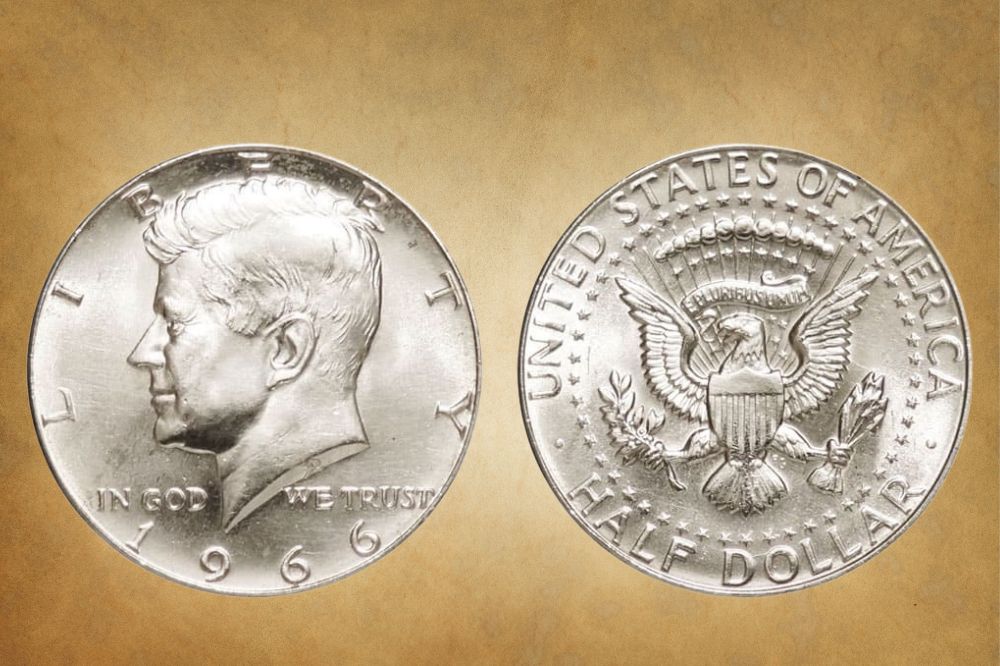
Do you have 1966 half-dollar coins and are curious to know how much they are worth? These coins were minted more than four decades ago so it is natural to wonder: Is my 1966 half-dollar worth anything?
The good news is that Kennedy half dollars from 1966 are worth more than their face value. The 1966 half-dollar value can go up to several thousand dollars depending on the coin’s condition.
In this article, I explain everything you need to know about the value of a 1966 half-dollar. We will explore the history of Kennedy dollars, look at the coin’s unique features, and discover the various varieties and types of errors worth hundreds or thousands of dollars.
Let’s jump in!
1966 Half Dollar Value Chart |
||||
| Mint Mark | Good | Fine | Extremely Fine | Uncirculated |
| 1966 No-mint mark Half Dollar Value | $4.75 | $4.75 | $4.75 | $20,000 |
| 1966 SMS Half Dollar Value | – | – | – | $1,200 |
1966 Half Dollar Value Guides
In this section, we’ll take a deep dive and learn more about the 1966 half-dollar value. Read on to find out whether your Kennedy half-dollar from 1966 is worth anything.
In 1966, the Mint produced two varieties of the half dollar. These include:
- The 1966 No-mintmark Half Dollar
- The 1966 Special Mint Set Half Dollar
Let’s look at each coin type to discover how much the 1966 half-dollar is worth
1966 No-Mintmark Half Dollar Value
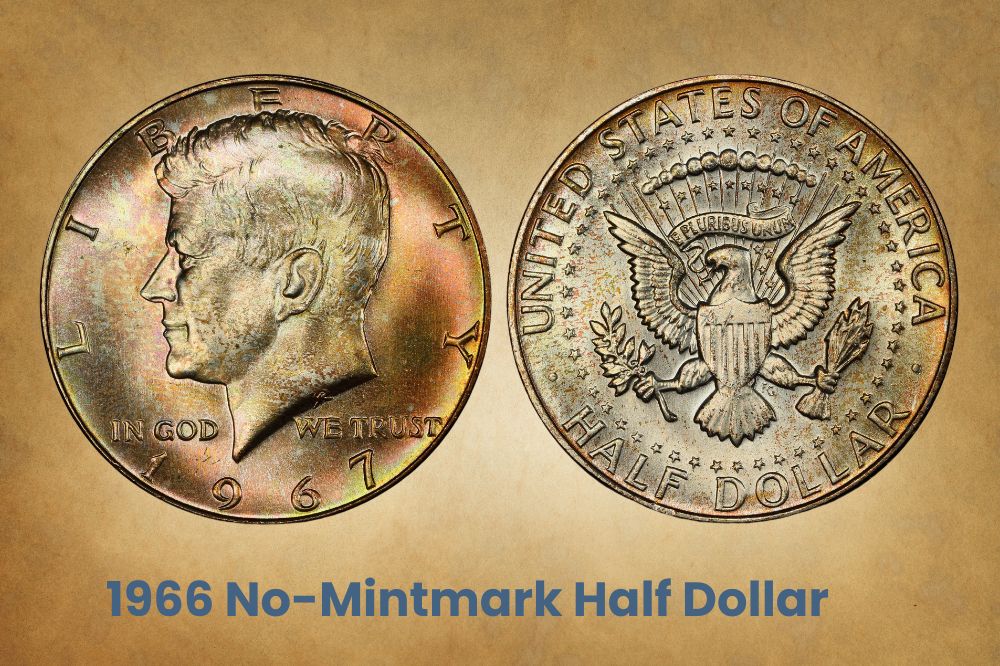
Most of the Kennedy half dollars from 1966 were minted at the Philadelphia facility. Like all coins minted in Philly, the 1966 half-dollar does not have a mint mark.
As mentioned, 108,984,932 of these coins were minted that year. This large number of coins means that 1966 coins are still in circulation, but most are worn out or damaged.
Despite the high coin mintage and the fact that most examples are in circulated condition, 1966 Kennedy half dollars are worth more than face value.
In average circulating condition, the 1966 no-mintmark half dollar value is $4.65, but it can be as expensive as $20,000 in the highest grade.
Finding 1966 half dollars in grades above mint state (M.S.) is extremely difficult because most of these coins are in circulation, and collectors hoarded the ones in mint state in rolls and bags as soon as the coin was minted.
Between 1964 and 1970, all coins did not have a mint mark, not just those minted at the Philadelphia facility. This era was known as the period of anonymous coins, and it was a difficult time for coin collectors who value knowing about a coin’s mint marks.
The government blamed collectors for the coin shortage of the early 1960 and temporarily stopped using mintmarks and producing proof coins to stabilize the coin market.
History later proved that the coin collectors did not cause the coin shortage. Rather, the shortage was due to poor planning causing a hitch in the distribution of coins that saw coins held in storage for weeks.
1966 Half Dollar Special Mint Sets
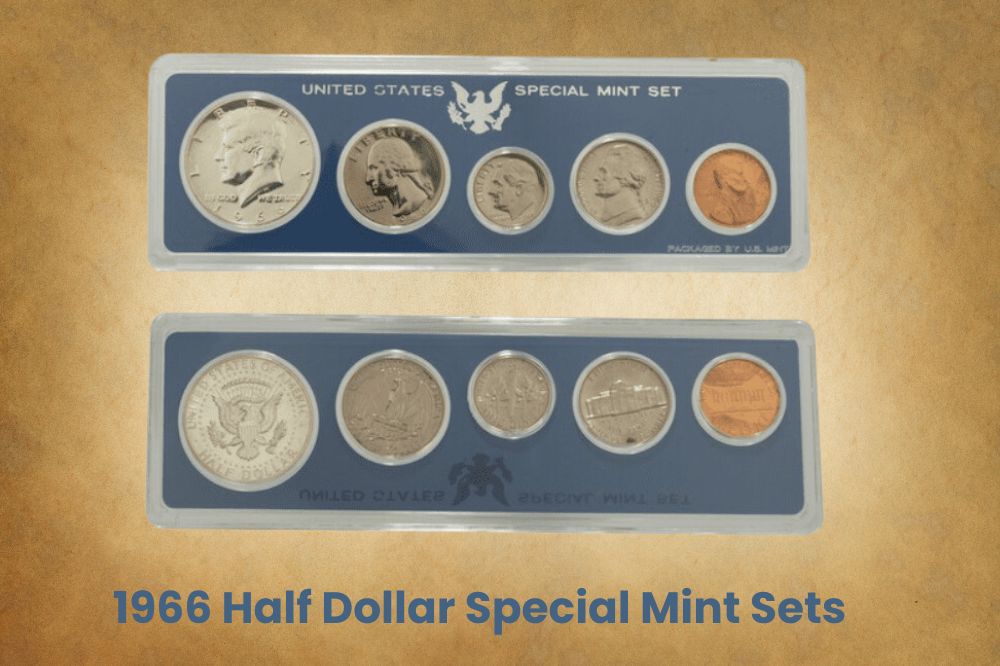
In some years, such as in 1966, the U.S. Mint produced special mint sets instead of proofs for collectors. Special mint sets (SMS) are much higher quality than regular circulation coins but are less premium than proof coins.
SMS coins are struck twice on clear, high-quality blank planchets, resulting in coins with a silky feel, shiny appearance, and an intense and visible design.
The San Francisco mint produced 2,261,583 special mints set half dollars in 1966. Collectors could buy this set for $4 at the time.
Today, you can obtain a special mint set of 1966 half dollars fairly easily. But, the cameo and ultra-cameo are few and apart, but you can obtain these SMS coins at a premium.
SMS half dollars from 1966 are worth between $5.25 in MS60 and $75 in MS67. Examples of higher grades above MS66 are extremely rare and can be worth up to $1200.
Related Posts: 26 Most Valuable Half Dollar Coins In Circulation
1966 Half-Dollar Errors
Familiarizing yourself with half-dollar errors from 1966 can help you identify the best coins to collect that might be worth hundreds or thousands of dollars.
Here are the most common 1966 half-dollar errors you should pay attention to:
1966 Half Dollar Straight Clip Error
The straight clip coin error occurs quite frequently on the 1966 Kennedy a half dollar.
The straight clip error happens when the striking die punches the blank planchet outside the planchet’s strip.
The erroneous punching causes one of the planchet’s edges to overlap, making the coin look like a section has been cut out or clipped. Instead of having a curved, circular edge, the coin features a straight, clipped edge.
A straight clip error half dollar from 1966 is worth $84.
1966 Half Dollar Missing Obverse Cladding Error
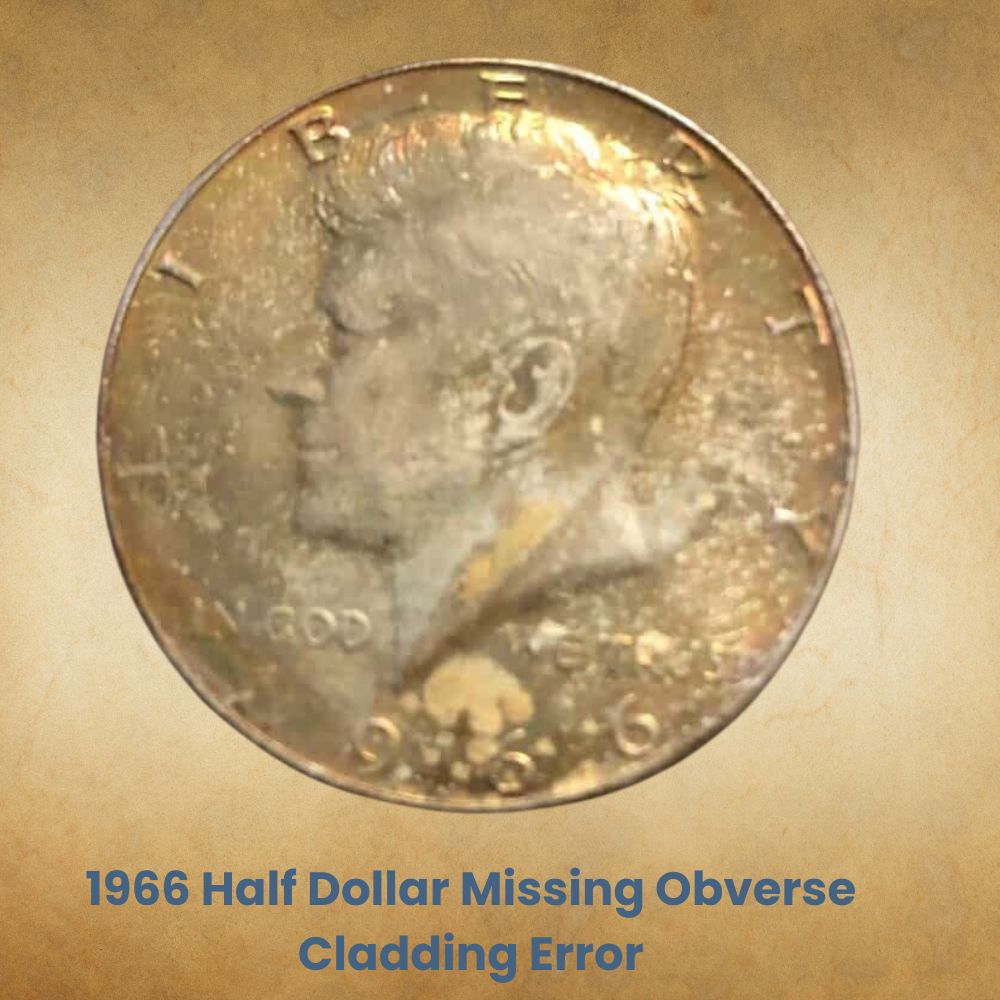
The missing obverse cladding happens when the mint does not apply cladding to the coin’s upside or head.
Because of a lack of cladding, the coin will appear to have different tones between the obverse and reverse sides. The obverse side will have a rougher texture, and the details will be less visible.
A 1966 half dollar missing obverse cladding error can be worth up to $ 126.
1966 Half Dollar Struck Through Error
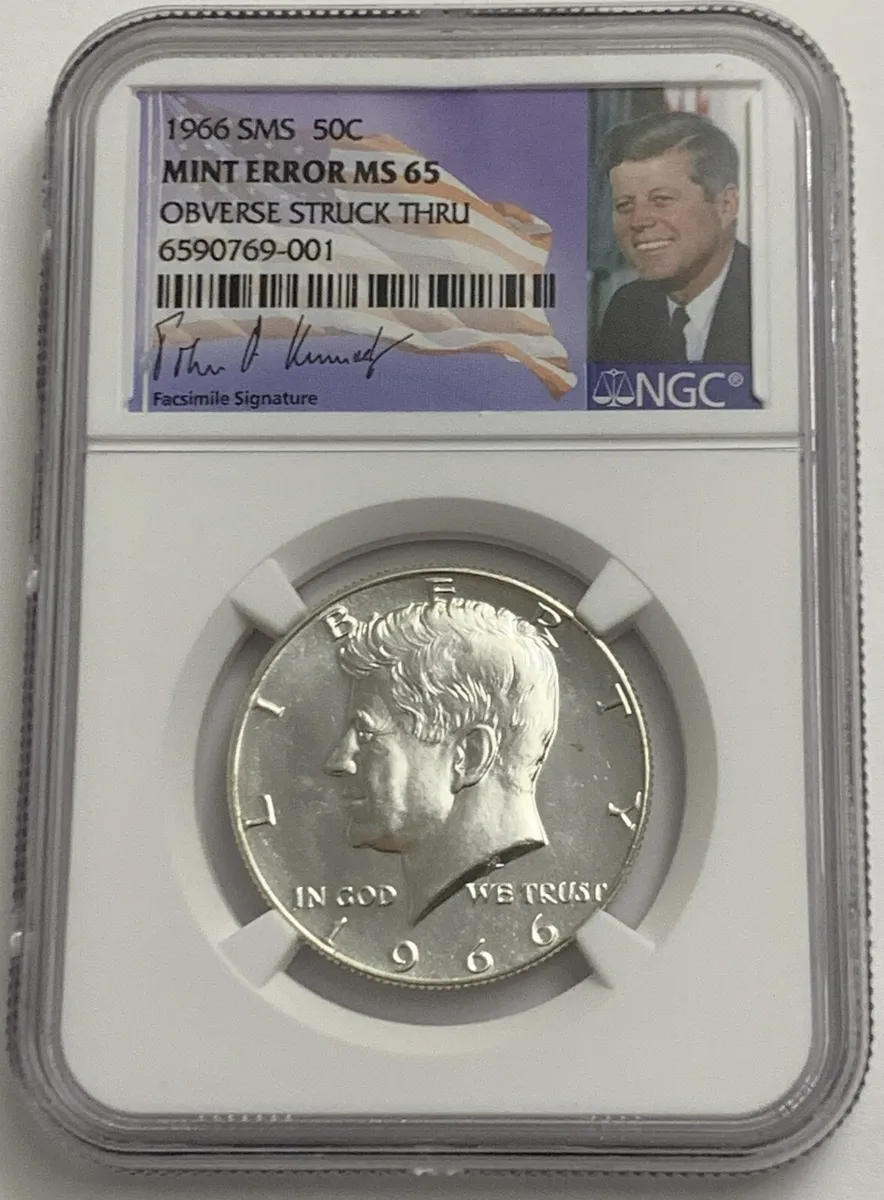
A struck-through error is quite interesting and can be worth thousands of dollars depending on the visibility of the strike-through.
A struck-through error happens when an unwanted object such as debris, a string of hair or a speck of wood or dust lands on the die or planchet, leaving the object’s image on the coin’s surface.
The struck-through error is rare. If you inspect your 1966 half-dollar coins and notice that something has been imprinted on the coin’s surface, you might have a 1966 half-dollar worth thousands of dollars.
Auctions sold the most expensive 1966 half-dollar struck-through error coin at $2500.
1966 Half Dollar Rotated Die Error
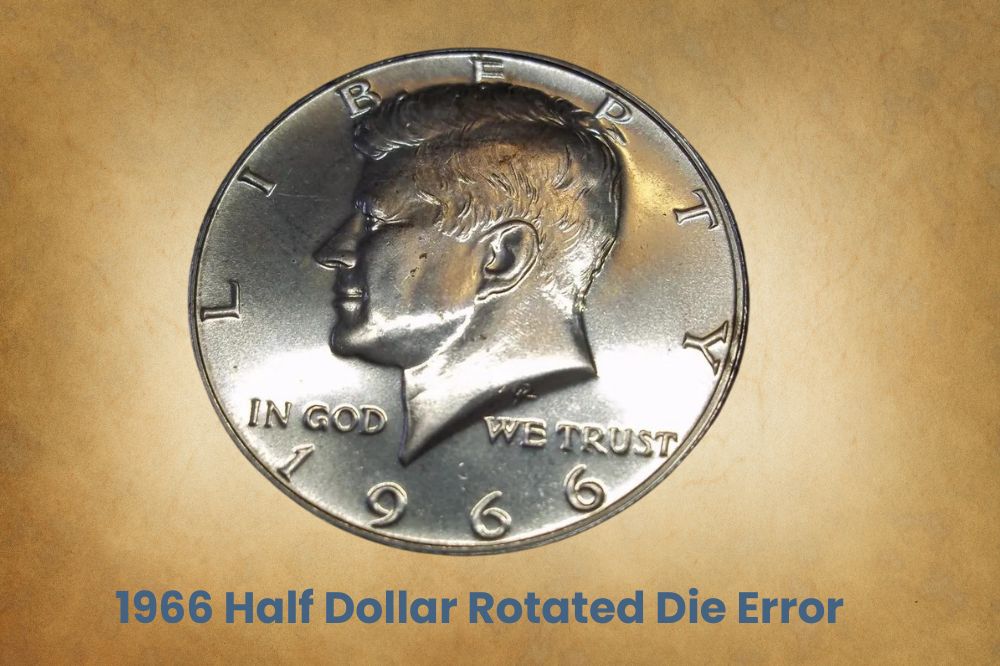
During the minting process, the mint workers align the coins so that the reverse is correctly oriented vis-à-vis the obverse side, even if the coin is overturned from top to bottom for minting.
A rotated die error occurs when the obverse and reverse sides of the coin are oriented wrongly such that both face the same direction.
The most expensive 1966 half dollar rotated die error coin was sold at $400.
Related Posts: 17 Most Valuable Kennedy Half Dollar Worth Money
History of the 1966 Half Dollar
The United States Mint produced the Kennedy half dollar to commemorate President John Fitzgerald Kennedy, one of the country’s most beloved presidents following his tragic assassination.
Soon after his death, the Treasury, Mint, and the President’s family came together to discuss the creation of a new coin that would monumentalize him. Several coins were up for consideration to be replaced by a Kennedy coin, and after much consultation and forethought, they agreed to replace Benjamin Franklin’s half-dollar.
Chief engraver, Gilroy Roberts, oversaw the coin’s design, ensuring that minting could start immediately.
To save time, Roberts and his assistant, Frank Gasparo, modified a few designs they had created earlier in 1961 of President JFK for the presidential series medal. Roberts worked on the obverse design while Gasparo worked on the reverse.
By December, trial half dollars were minted and the Treasury approved the designs, which became examples from which circulation coins were minted.
The Treasury introduced the first Kennedy half dollars into circulation in March 1964, about four months after the President’s assassination. There was such a high demand for the new coin that all 70,000 half dollars initially offered to the public were sold out by mid-morning.
That year, collectors hungrily hoarded Kennedy half dollars despite the Treasury’s effort to mint more half dollars, eventually leading to a silver shortage.
By 1966, all coins were made from only 40% silver and 60% copper instead of the previous composition of 90% silver and 40% nickel.
That year a total of 108,984,932 half dollars were minted at the Philadelphia mint and released into circulation. The Treasury also commissioned the minting of special mint sets at the San Francisco facility, and 2,261,583 of these coins were minted.
The Kennedy half dollars from 1966 do not feature a mint mark; it can be hard to tell from which mint a 1966 half-dollar came. As part of the popular Kennedy half dollars, the 1966 half dollar is highly sought after among collectors.
Related Posts: 18 Most Valuable Franklin Half Dollars Worth Money
How to Identify 1966 Half Dollar?
Let us now look at the unique features of the 1966 Kennedy half dollar.
The Obverse of the 1966 Half Dollar
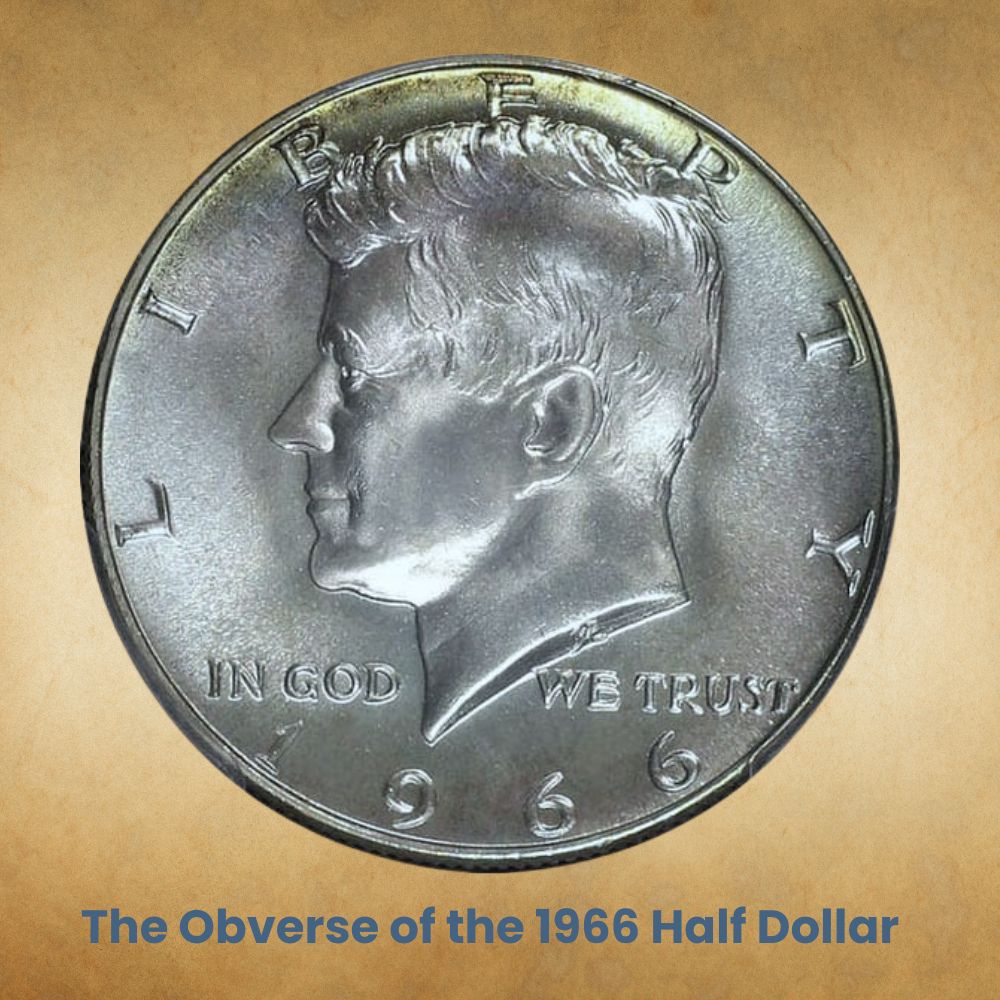
The obverse is the upward-facing side of a coin and is also known as the heads. The obverse of the 1966 half dollar features the bust or profile of President John Fitzgerald Kennedy facing to the left. In the profile, the President displays a subtle smile.
Around the top half of the coin are the words LIBERTY while the year of issue, 1966, takes up the bottom half.
The motto: IN GOD WE TRUST appears horizontally across the coin at the bottom of the President’s profile.
The Reverse of the 1966 Half Dollar
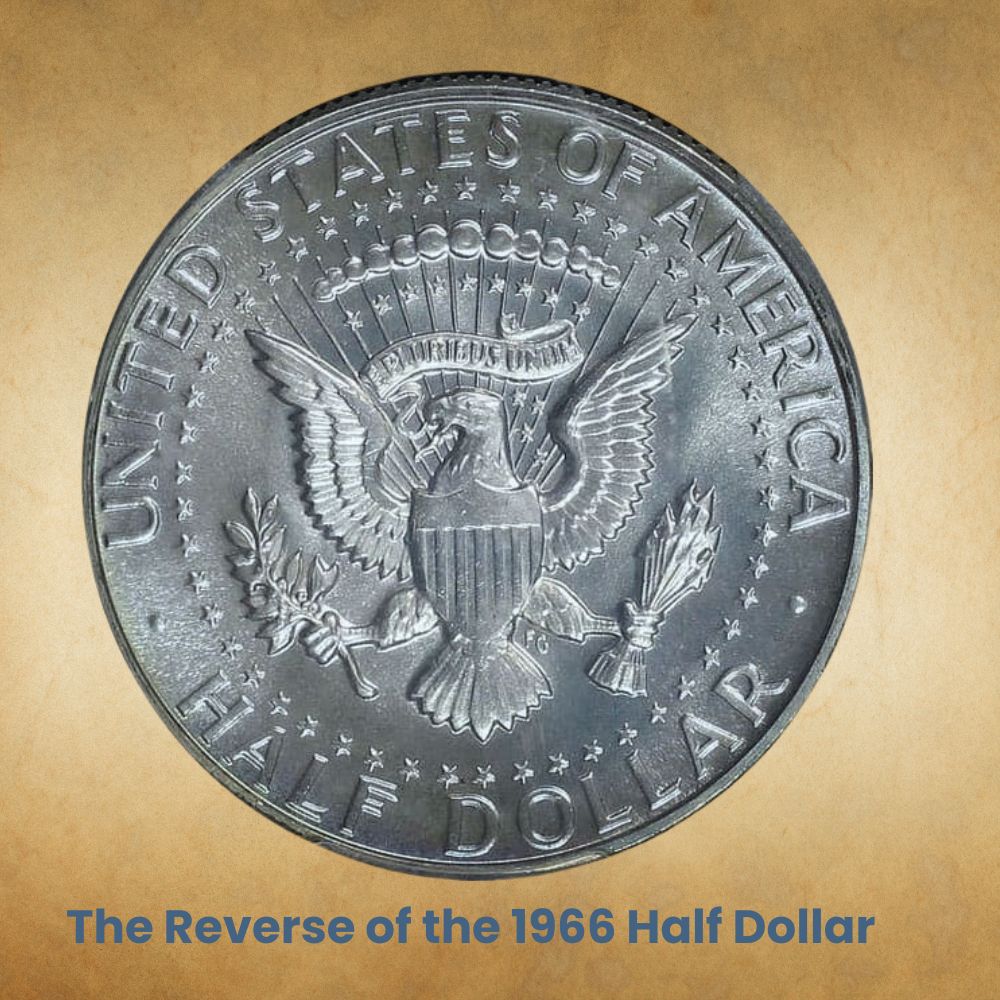
The coin’s reverse is the back side, also known as the tail. The Kennedy 1966 half dollar features an intricate reverse side with a left-facing bald eagle adorned in the President’s Coat of Arms.
The eagle holds an olive branch in one talon and arrows in the other, representing peace and security.
The eagle also grasps a flying flag in its beak with the motto E PLURIBUS ENUM imposed on it. Fifty-two stars surround the eagle and represent the united states.
Around the top of the coin’s reverse are the words UNITED STATES OF AMERICA while the coin’s denomination, HALF DOLLAR, appears around the bottom edge. A dot on each side separates the words at the top and bottom of the coin.
Other Features of the 1966 Half Dollar
The 1966 Kennedy half dollar comprises 40% silver and 60% copper.
The coin weighs 11.5 grams and has a diameter of 30.6mm.
The circulation mintage is 108,984,932 from the Philadelphia mintage, while the Mint produced 2,261,583 special mint sets at the San Francisco mint.
The Kennedy half dollars from 1966 do not have a mint mark.
FAQs
Here are a few common questions about the 1966 half dollar value.
Is the 1966 half dollar silver?
Kennedy half dollars from 1966 are 40% silver. The coins contain 0.1479 troy ounces of silver, equivalent to 4.6 grams pure silver. This shows that the silver content in a single 1966 half dollar is quite negligible and may even be worth more or less the face value. To check that your half dollar is silver, inspect its edges where the most wear and tear happens if you see a silver stripe underneath the wear and tear, that is a sure sign that your 1966 half dollar is indeed silver.
Where is the mint mark on a 1966 Kennedy half dollar?
The 1966 half dollars belong to the so-called ”anonymous coin” era that began in 1964. Between 1964 and 1970 the government temporarily halted the production of proof coins for collectors and stopped using mintmarks. The goal of this tactic was to discourage collectors from hoarding coins based on their mintmarks. Although the 1966 half dollars were minted in Philadelphia and San Francisco, it is impossible from which which mint because these coins do not have any mintmark.
What is the melt value of a Kennedy half dollar?
In circulated condition, the 1966 half dollar is worth its weight in silver, attributable to the coin’s 40% silver content. The melt value for Kennedy half dollars minted in 1966 is $3.56 based on the spot price of silver bullion, which is $24.05 per ounce as of December 2022.
